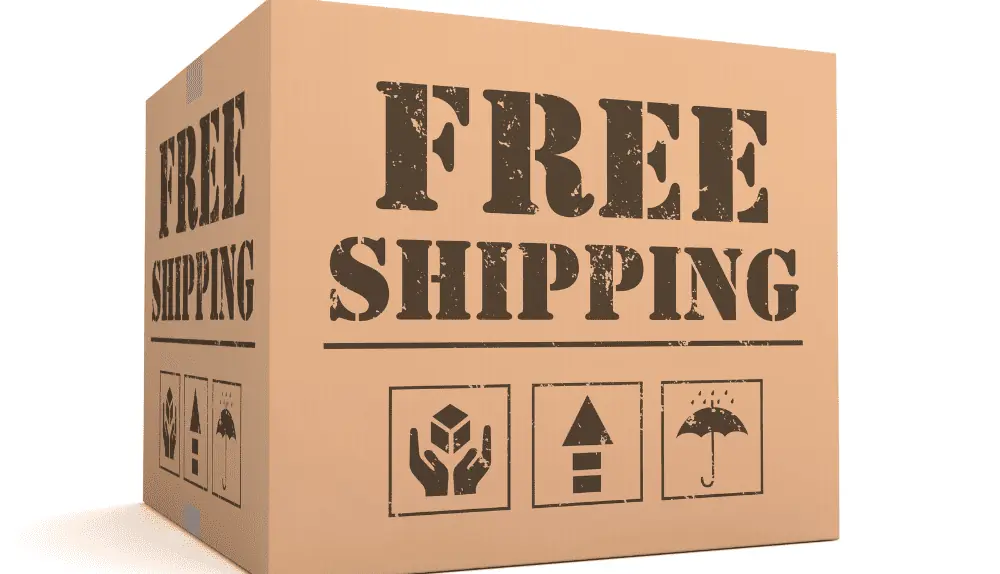In the ever-evolving world of e-commerce, there is a game-changer that has revolutionized the way we shop online: “Free Shipping.” Yes, those two simple words hold incredible power, enticing customers and driving sales like never before. In fact, recent statistics reveal that “Free Shipping” is not just a catchy marketing phrase but a force to be reckoned with, responsible for over 40% of all e-commerce retail subscriptions.
In this digital era, where convenience reigns supreme, it’s no wonder that customers have come to expect and even demand this cost-saving perk. Join us as we delve into the fascinating realm of free shipping and explore how it has transformed the landscape of online retail, captivating shoppers and reshaping the very nature of consumer behavior. Get ready to embark on a journey where convenience, customer loyalty, and unprecedented growth intersect, all thanks to the power of Free Shipping.
How Free Shipping Works?

Free shipping is a marketing strategy employed by online retailers to attract customers and increase sales. The concept is simple yet powerful: customers make a purchase, and the retailer covers the cost of shipping the items to the customer’s designated address, eliminating any additional fees typically associated with delivery.
While the mechanics of free shipping can vary across different retailers and platforms, the underlying principle remains consistent. Online stores either absorb the shipping expenses themselves or negotiate special agreements with shipping carriers to minimize or eliminate the costs altogether.
This enticing offer has proven to be highly effective in driving customer acquisition, enhancing customer satisfaction, and ultimately boosting conversion rates. By removing the barrier of shipping costs, free shipping has become a catalyst for increased online sales, as customers are more likely to complete their purchases and even explore additional items within the retailer’s inventory. This strategy has reshaped the e-commerce landscape and has become a staple feature in the battle for customer loyalty and market share.
Benefits of Free Shipping for E-Commerce Businesses

In the fiercely competitive world of e-commerce, businesses are constantly seeking ways to stand out and attract customers. One strategy that has emerged as a game-changer is offering free shipping. This powerful perk has revolutionized the online shopping experience, providing customers with added value and convenience. The benefits of free shipping extend beyond customer satisfaction, as it also brings numerous advantages to e-commerce businesses. From increased conversion rates and enhanced customer loyalty to gaining a competitive edge and boosting average order value, free shipping has become an indispensable tool for driving growth and success in the digital marketplace. Let’s explore the benefits that free shipping offers to e-commerce businesses in more detail.
Increased Conversion Rates
One of the most significant benefits of offering free shipping is the substantial increase in conversion rates. When customers are presented with the option of free shipping, they are more likely to proceed with their purchases and complete the checkout process. The elimination of additional shipping costs removes a common deterrent and encourages customers to make buying decisions without hesitation. This leads to higher conversion rates, translating into more sales and revenue for e-commerce businesses.
Enhanced Customer Satisfaction and Loyalty
Free shipping has a profound impact on customer satisfaction and loyalty. By providing this perk, businesses demonstrate their commitment to delivering value and convenience to their customers. Shoppers appreciate the cost savings and the seamless shopping experience that free shipping provides. This positive experience fosters trust and loyalty, encouraging customers to return for future purchases. Satisfied customers are also more likely to recommend the retailer to others, expanding the customer base through word-of-mouth marketing.
Competitive Advantage
In a highly competitive e-commerce landscape, offering free shipping can give businesses a significant edge over their rivals. With customers becoming increasingly accustomed to free shipping options, it has become an expectation rather than a luxury. By meeting this demand, businesses can differentiate themselves from their competitors and attract customers who prioritize cost savings and convenience. This competitive advantage can lead to increased market share and establish the retailer as a go-to destination for online shopping.
Increased Average Order Value
Another benefit of free shipping is its potential to boost the average order value for e-commerce businesses. Customers, motivated by the desire to qualify for free shipping, may be inclined to add more items to their cart to meet the minimum threshold. This “free shipping threshold” becomes a powerful tool to upsell and cross-sell, encouraging customers to explore additional products and potentially make larger purchases. As a result, businesses can enjoy a higher average order value and increased revenue per transaction.
Reduced Cart Abandonment
Cart abandonment is a common challenge in e-commerce, with high shipping costs being one of the leading reasons why customers abandon their carts. By offering free shipping, businesses can address this issue and reduce cart abandonment rates. Customers are more likely to follow through with their purchases when they realize they can avoid the additional shipping cost. As a result, free shipping helps businesses recover potential sales that would have otherwise been lost due to abandoned carts.
Overall, the benefits of offering free shipping in e-commerce are numerous and impactful. From increased conversion rates and customer loyalty to gaining a competitive advantage and boosting average order value, free shipping has proven to be a strategic tool for driving growth and success in the online retail industry. By meeting the expectations of today’s consumers and providing a seamless shopping experience, businesses can harness the power of free shipping to thrive in the digital marketplace.
How to Avoid Shopping Cart Abandonment?

Shopping cart abandonment is a common challenge faced by e-commerce businesses, but there are several strategies that can help reduce its occurrence and improve conversion rates. Here are some effective ways to avoid shopping cart abandonment:
Simplify the Checkout Process
Make the checkout process as simple and user-friendly as you can. Reduce the amount of time needed to finish a purchase and get rid of any extra form fields. Give customers the opportunity to check out as a guest to avoid needing them register for an account beforehand.
Display Clear and Transparent Pricing
Be upfront about all costs, including shipping fees, taxes, and any additional charges. Surprise costs that appear during the checkout process can lead to cart abandonment. Provide an estimated total cost early in the shopping journey to set clear expectations.
Offer Multiple Payment Options
Provide customers with a variety of payment options, including credit cards, debit cards, digital wallets, and alternative payment methods. Offering popular and trusted payment options can increase customer confidence and reduce friction during checkout.
Implement a Cart Abandonment Recovery Strategy
Set up automated cart abandonment emails to remind customers about their unfinished purchases. Include personalized incentives, such as discounts or free shipping, to encourage customers to complete their transactions. Timing is crucial, so send reminders shortly after abandonment to maximize effectiveness.
Optimize Website Performance
Ensure your website is fast, responsive, and mobile-friendly. Slow-loading pages or a cumbersome browsing experience can frustrate customers and lead to cart abandonment. Regularly monitor and optimize your site’s performance to provide a smooth shopping experience.
Offer Free Shipping or Shipping Incentives
As discussed earlier, free shipping is a powerful incentive that can reduce cart abandonment. Consider offering free shipping above a certain order value or providing limited-time shipping promotions to encourage customers to complete their purchases.
Display Trust Indicators
Build trust with your customers by displaying trust badges, security seals, customer reviews, and ratings on your website. These trust indicators help alleviate concerns about security and reliability, boosting customer confidence and reducing cart abandonment.
Provide Live Chat Support
Offer real-time customer support through live chat. Promptly address any concerns or questions customers may have during the checkout process. Live chat support can help overcome last-minute hesitations and guide customers towards completing their purchases.
Implement Exit-Intent Pop-ups
Use exit-intent pop-ups to capture customers’ attention when they are about to leave the website. Offer incentives, such as discounts or exclusive offers, to entice customers to reconsider and complete their purchases.
Continuously Optimize and Test
Regularly analyze cart abandonment data to identify trends and areas for improvement. Conduct A/B testing to optimize different elements of the checkout process, such as button placement, form fields, or promotional offers, to find the most effective strategies for reducing cart abandonment.
By implementing these strategies, businesses can significantly reduce shopping cart abandonment rates and improve overall conversion rates, increasing sales and revenue.
How to Implement Free Shipping on E-Commerce Platform?
Implementing free shipping in your e-commerce business can be a strategic move to attract customers and boost sales. Here are some steps to consider when implementing free shipping:

Analyze Your Cost
Begin by evaluating your product costs, shipping expenses, and profit margins. Determine if offering free shipping is financially feasible for your business. Consider factors such as product weight, size, and shipping distances to get a clear understanding of the impact on your bottom line.
Set Minimum Order Threshold
Implement a minimum order value to qualify for free shipping. This encourages customers to increase their order size to meet the threshold, which can help offset the cost of shipping. Set the threshold strategically to balance customer expectations and your business objectives.
Negotiate Shipping Rates
Establish relationships with shipping carriers and negotiate competitive rates. Bulk shipping contracts or partnerships can help reduce shipping costs, making it more feasible to offer free shipping to your customers. Compare rates from different carriers and choose the most cost-effective options for your business.
Adjust Product Pricing
Consider adjusting your product prices to account for the shipping costs. This allows you to offer free shipping while still maintaining profitability. Calculate the average shipping cost per order and incorporate it into your product pricing strategy.
Promote Free Shipping
Clearly communicate the availability of free shipping throughout your website and marketing channels. Highlight it prominently on product pages, banners, and checkout pages to ensure customers are aware of the offer. Use persuasive copywriting to emphasize the value and benefits of free shipping to potential customers.
Test and Optimize
Monitor the impact of free shipping on your conversion rates, average order value, and overall profitability. Analyze customer behavior and sales data to identify trends and make data-driven decisions. Consider conducting A/B testing to fine-tune your free shipping strategy, such as testing different minimum order thresholds or promotional offers.
Leverage Limited-Time Promotions
Create a sense of urgency and excitement by offering limited-time free shipping promotions. This can motivate customers to take immediate action and make a purchase. Use email marketing, social media, and other marketing channels to communicate these time-sensitive offers effectively.
Communicate Delivery Expectations
Clearly communicate the estimated delivery times and any potential limitations or exceptions associated with free shipping. Managing customer expectations is crucial to avoid dissatisfaction due to longer shipping times or other potential delays.
Monitor and Adjust as Needed
Continuously monitor the impact of free shipping on your business metrics and customer feedback. Be prepared to make adjustments to your free shipping strategy as needed to ensure it aligns with your business goals and remains financially viable.
Remember, implementing free shipping requires careful planning and analysis to ensure it is a sustainable and profitable option for your e-commerce business. By offering free shipping strategically and effectively, you can attract customers, increase sales, and enhance customer loyalty in the competitive e-commerce landscape.
Is Free Shipping a Good Idea?
Offering free shipping can be a highly effective strategy for many e-commerce businesses. While it may not be suitable for every situation or business model, it has proven to be a successful approach for attracting customers, boosting sales, and improving customer satisfaction. Here are some factors to consider when evaluating whether free shipping is a good idea for your business:
Customer Expectations
Free shipping has become an expectation for many online shoppers. Customers often prioritize cost savings and convenience, and offering free shipping can help meet their expectations, increase customer satisfaction, and enhance their shopping experience.
Competitive Advantage
In a highly competitive e-commerce landscape, free shipping can give your business a competitive edge. It can differentiate your brand from competitors and attract customers who prioritize cost-saving incentives. By offering free shipping, you position yourself as a customer-centric business, potentially leading to increased market share and customer loyalty.
Conversion Rates
Offering free shipping has been shown to improve conversion rates significantly. By removing the barrier of shipping costs, customers are more likely to complete their purchases and reduce shopping cart abandonment. This can translate into higher sales and increased revenue for your business.
Average Order Value
Free shipping can also help increase the average order value. Customers may be motivated to add more items to their cart to qualify for free shipping thresholds. This upselling and cross-selling opportunity can lead to larger transactions and higher revenue per customer.
Cost Considerations
While free shipping can attract customers, it’s essential to evaluate the financial implications for your business. Assess the impact on your profit margins, shipping costs, and overall profitability. You may need to adjust product prices or set minimum order thresholds to make free shipping financially sustainable.
Target Audience
Consider your target audience and their preferences. Free shipping may be more appealing to certain demographics or industries. Conduct market research and analyze customer behavior to understand if free shipping aligns with your target market’s expectations and purchasing patterns.
Product Suitability
Evaluate whether your products lend themselves well to free shipping. Products that are lightweight, have high profit margins or can be easily shipped at a low cost are generally more suitable for free shipping offers. For bulky or heavy items, it may be more challenging to absorb shipping costs entirely.
Ultimately, the decision to offer free shipping depends on your specific business circumstances, target audience, and financial considerations. It’s important to analyze the potential benefits, costs, and impact on profitability before implementing a free shipping strategy. By carefully evaluating these factors, you can determine if free shipping is a good fit for your e-commerce business and if it aligns with your overall goals and objectives.
Pros and Cons of Free Shipping
Pros of Free Shipping
- Increased Conversion Rates: Offering free shipping has been shown to improve conversion rates significantly. By eliminating the additional shipping cost, customers are more likely to complete their purchases, reducing shopping cart abandonment and increasing sales.
- Customer Satisfaction and Loyalty: Free shipping is a highly valued perk for customers, enhancing their shopping experience and increasing satisfaction. By providing this convenience, businesses can build customer loyalty, encourage repeat purchases, and generate positive word-of-mouth recommendations.
- Competitive Advantage: In a crowded e-commerce market, offering free shipping can give businesses a competitive edge. It differentiates your brand from competitors and attracts customers who prioritize cost-saving incentives, potentially leading to increased market share.
- Increased Average Order Value: Free shipping can incentivize customers to add more items to their cart to meet the minimum order threshold. This can result in larger transactions and higher average order values, boosting revenue per customer.
- Reduced Cart Abandonment: High shipping costs often contribute to shopping cart abandonment. By offering free shipping, businesses can reduce this barrier and encourage customers to complete their purchases, recovering potential lost sales.
Cons of Free Shipping
- Impact on Profit Margins: Absorbing shipping costs can put pressure on profit margins, especially for businesses with tight margins or low-priced products. It’s essential to carefully evaluate the financial implications and ensure that offering free shipping is sustainable and profitable.
- Increased Product Pricing: To offset shipping costs, businesses may need to increase product prices, which can impact competitiveness. Customers who compare prices across multiple platforms may be deterred if they perceive higher prices to compensate for free shipping.
- Minimum Order Threshold Challenges: Setting a minimum order threshold to qualify for free shipping can be a double-edged sword. While it encourages higher-order values, it may also deter customers who do not meet the threshold or perceive it as unattainable.
- Limited Margins for Certain Products: Products with low-profit margins, heavyweight, or specialized shipping requirements may not be suitable for free shipping. The cost of shipping these items may outweigh the benefits of offering free shipping.
- Potential Returns and Losses: Offering free shipping increases the likelihood of returns, which can impact profitability. Businesses need to factor in the costs associated with return shipping and potential losses due to returned products.
Final Words
In conclusion, the decision to offer free shipping in e-commerce involves weighing the pros and cons to determine its suitability for your business. Free shipping can be a powerful tool to drive conversion rates, enhance customer satisfaction, and gain a competitive advantage. It can increase average order value and reduce cart abandonment, leading to improved sales and customer loyalty.
However, businesses must carefully evaluate the impact on profit margins, product pricing, and financial sustainability. Not all products or industries may be well-suited for free shipping, and alternative strategies such as tiered shipping or shipping promotions may be more appropriate. By considering these factors and aligning the decision with your business goals, target audience, and financial considerations, you can make an informed choice about whether free shipping is the right strategy for your e-commerce business.
Frequently Asked Question
Is free shipping really free?
Free shipping means that the shipping cost is absorbed by the retailer, and customers do not have to pay any additional fees for the delivery of their purchases. However, it's important to note that the shipping cost is typically factored into the product prices or minimum order thresholds.
Is free shipping available internationally?
Free shipping policies can vary depending on the retailer. While some e-commerce businesses may offer free international shipping, it is more commonly offered for domestic or specific regional markets. International shipping costs and customs fees can be significant, making it challenging to provide free shipping globally.
What happens if I return a product that was purchased with free shipping?
Return policies vary by retailer, but in most cases, if you return a product that was originally shipped for free, the cost of return shipping may be deducted from your refund. It's important to review the specific return policy of the retailer to understand any potential costs associated with returns.
Can I combine free shipping with other discounts or promotions?
Retailers may have specific policies regarding combining free shipping with other discounts or promotions. Some may allow it, while others may have restrictions. It's advisable to review the terms and conditions or contact customer support to understand if free shipping can be combined with other offers.

